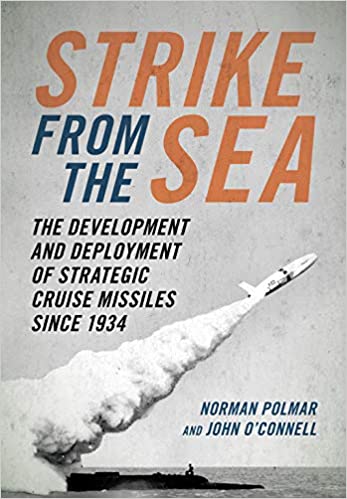Naval Cruise Missiles: A History
Cruise missiles have been a key part of the US Navy’s arsenal and that of the Soviet and Russian navies for some time.
The history of these missiles within these two navies is highlighted in the new book by Norman Polmar and John O’Connell.
As they argue at the outset of their book:
“Much of this book addresses the U.S. Navy’s Regulus missile program—the world’s first submarine weapon for attacking an enemy homeland with a nuclear warhead—and the Soviet Navy’s similar cruise missile efforts. Prior to Regulus, a few of the world’s submarines had deck guns for assaulting coastal targets; indeed, the British built a class of “submarine monitors” with large-caliber guns for that purpose.
“After the Regulus, more advanced cruise missiles and ballistic missiles were sent to sea in submarines to attack an enemy’s cities and military installations. Certain of these U.S. and Soviet/Russian land-launched, nuclear-armed cruise missiles also are examined in the context of their competitiveness with sea-based missiles for roles and resources. Also, at times, briefly, the services considered the technology of other services’ missiles for their own use.”
The book provides a detailed look at Regulus and the evolution beyond Regulus of this class of missile in the American and Soviet/Russian navies.
The end the book posing the question of the way ahead.
They highlighted the impact of ending the INF treaty and how that might affect American strike missile development.
They highlighted as well the hypersonic missile race as part of the way ahead.
But I would argue that the question of the future of joint force missile development and operations is opening a new chapter.
Part of it is associated with the emergence of the kill web, an era in which evolving ISR capabilities are reshaping strike and the role of third party strikes called in from a wide variety of platforms to diverse target sets.
Part of it is the end of a particular TLAM era, because of their vulnerabilities in the denied combat environment domain, or the question of vulnerabilities from the space links or the challenges posed by adversary electronic or tran warfare,
And the Chinese dynamic of missile development and proliferation will reshape how to deal with strike, requiring both offensive and defensive capabilities and creative mixes of the two into new strike denial capabilities.
As blue water maneuver returns along with blue water expeditionary operations, a new chapter is opening on weaponization.
Another aspect of that dynamic is the question of weapons mixes, stockpiles and target utility.
“Why use a million dollar missile to kill a low value target,” was how one US Navy officer put it to me.
Stockpiles are too low for 21st century warfare; and the weapons mix is out of skew with the nature of the threat environment.
And with regard to speed, perhaps hyperconiscs is not the best way to get the most effective speed to target, but this is a work in progress.
With the coming of directed energy weapons at sea, the weapons mix will change as well.
In other words, I think this book does a great job of providing a history of an era; but I would argue that we are entering a new one, in which the fleet is seriously rethinking how to deliver maritime strike, against land and sea targets.
And with the Chinese posing a direct threat from the sea to USAF bases and facilities, the USAF has entered clearly into a rapidly deepening relationship with the US Navy to find ways to target the threats that matter most to them as operating forces.
And with the Second Nuclear Age in full form, the question of how to deal with the mix of conventional and nuclear threats its becoming center stage.
The Russians have clearly lowered the nuclear threshold in Europe to compensate for weaknesses in their conventional forces; and with regard to China and its first island chain, this will be primarily a mission area for the USAF and its leadership sorting through the nuclear/conventional targeting mix. The coming of the B-21 enters exactly into this arena.

